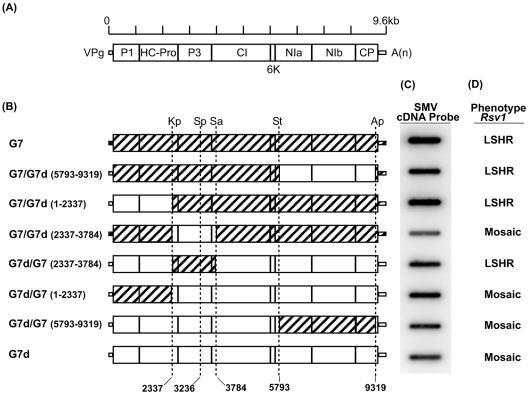FIG. 1.
Chimeric viruses and their phenotypic responses on soybean line PI 96983 (Rsv1). (A) Proposed genomic map of SMV (35). (B) Schematic representation of chimeric viruses constructed by exchanging fragments between pSMV-G7 (G7) and pSMV-G7d (G7d) utilizing the single restriction sites KpnI (Kp), SpeI (Sp), SalI (Sa), StuI (St), and ApaI (Ap) common between the two viruses. For construction of G7/G7d(1-2337) and G7d/G7(1-2337), the unique restriction site NotI located 669 nucleotides upstream of SMV sequences within vector sequences (data not shown) and the KpnI site were utilized. (C) Detection of progenies of the chimeric viruses in infected PI 96983 (Rsv1) soybean plants by slot blot hybridization. Following inoculation, plants were maintained in a growth chamber (20°C) until a leaflet from trifoliolates 3 and 4 of infected plants was collected 4 weeks postinoculation. Samples from corresponding trifoliolate leaflets of four independent replicate plants were combined; total RNA was isolated and denatured, and 10 μg was slot blotted onto a membrane and hybridized with 32P-labeled cDNA probes. (D) Phenotypic responses of soybean line PI 96983 (Rsv1) to mechanical inoculation with infectious sap containing progenies of parental or chimeric viruses. Following inoculation, the plants were maintained in a growth chamber (20°C) until virus-induced symptoms, mosaic or LSHR, were recorded about 6 weeks postinoculation.

